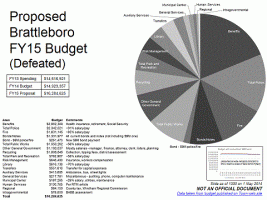 This pie chart shows all the town’s major budget areas so people can see graphically how they compare. The budget is largely driven by personnel costs – salaries, insurance, retirement, etc. – for the people providing us with services.
This pie chart shows all the town’s major budget areas so people can see graphically how they compare. The budget is largely driven by personnel costs – salaries, insurance, retirement, etc. – for the people providing us with services.
A lot of people seem to be writing and talking about the police-fire project as if the $9 million bond would be a major factor in the town budget. While it is certainly nothing to sneeze at and it may have been the straw the broke the camel’s back with respect to passing the budget, in the scope of all the town’s expenses the project is just that – a straw. Reducing the town’s budget (and property taxes) is by no means as simple as just skipping the $9M bond.
(Edit: slide tweaked Thursday afternoon to show $9M first bond payment more exactly as $261,473, add FY13 and FY14 budgets, and show scale of impact of $9M bond on future budgets.)








Advice from the Peanut Gallery
Reducing the town’s budget is hard. There is enormous tension between at least three driving forces: our property tax burden is already VERY high, people WANT all the services the town currently provides, and we MUST get our police and firefighters into safer facilities. I would hope that as the selectboard wrestles with the budget, they would keep these goals in mind.
Fix what we can
When you take out a bond, it is for a specific project. You just can’t take out a bond an decide later how to spend it.
Bob Fagelson
However...
…you can pay back part or all of the bond early, eliminating part or all of the interest payments.
No
No you cannot. You must take the full term of the bond
No
As Bob says, that’s not an option with this bond – it isn’t like a car loan or mortgage. The idea has been raised before (including at RTM); while there are such things as callable or redeemable bonds, that’s not what this is.
We borrowed $5,000,000 to do a year’s worth of the police-fire project and now we have to pay back $6,462,207 on a fixed schedule between FY14 and FY29, period. (The payments peak in FY15 at $479K and slowly go down to $341K in FY29).
Thanks
Thanks for the useful chart. Sometimes seeing a picture makes things more clear for some people. Nice work.
Numbers?
Glenn,
I agree that graphic representation are excellent aids in getting to an understanding. However, I was given the chart and table found at the link below and was told it was provided by the Town Treasurer ostensibly for the purpose of estimating the positive effect of the 1% option tax on the tax rate.
My question is how to reconcile this information with what you provided. The Treasurer’s info shows the Total (both bonds?) interest for 2015 at $740k. Just counting the “Year 1 Bond” (the one already taken out?) the figure – $479k, is almost twice the one you found.
The bigger issues seems to be increases in the ensuing years.
https://drive.google.com/file/d/0B1en0d0JFXz6cGhWTEhsNWpFSzA/edit?usp=sharing
clarification
The above graph also includes a detailed schedule of bond payments, separating out the two payments. This year would have been $263,000 on the 9 million. The payment for just that 2nd bond goes up to $767,000 next year and stays in that range (over $700,000) for 8 years. In 2016 we would start paying principal and interest, reason for the big jump, as with the 1st bond’s jump.
Bond Payments Over Time
Wow – that chart you linked to is great information. The bond payoff is low the first year, then jumps way up but goes down significantly over time.
Anyway, looking at that chart taking out the $9M bond only costs $261,473 this year (FY15); that’s the number shown in the pie chart. The $740K number you mention is that cost plus the FY15 portion of the $5M bond ($479,093), which we’re already committed to and is included in the pie chart as part of the $1.3M for current Bonds/Notes (which would also include anything else we’ve bonded for and are still paying off).
We’ve already taken out the $5M bond for the police-fire project; in FY14 it cost $123K, in FY15 it peaks at $479K, and then our payments go down slowly as we pay it off until the final payment in 2029 is $341K. If we take out the $9M bond, it will cost $261K in FY15, peak at $768K(!) in FY16, and then go down slowly until the final payment of $468K in 2035.
Bottom line: NEXT year (FY16) is when the police-fire project costs as currently planned (with both $5M and $9M bonds) would peak at $1,244K. That is indeed a significant amount of money… but the Brattleboro budget even without the new bond is still $16M.
Big pic
I appreciate the attempt to graphically present an overview, it’s very useful for long range planning.
In that light I believe it’s important to indicate, especially for those who may not know, municipal spending is just one third of where our tax dollars go. The other two thirds, more or less, go to the schools. Here is the idea visually:
{$} town 33%
{$$} schools 67%
Skool
A single chart putting schools and town budgets in one pie would be a good project for someone.
The school budgets, for the most part, have escaped the same public scrutiny and outcry that the town budget is going through in Brattleboro. Not so in other Vermont towns – I did a search looking for Vermont towns that voted down their budgets and most of the results were related to school budgets being voted down.
clear visuals of the town's finances
Whether pie chart or some other accessible visual form, to get an accurate, complete picture, don’t we need to see the following clarified:
1) the areas/amounts of the budget that get covered by non-taxpayer sources, for example the state in the form of homestead rebates; funds generated by other taxes, fines, and the like; etc. (are there others?)
2) any additional funding of town services that comes from outside sources–which departments obtain money from such sources, including in-kind and volunteer contributions, and how those funds are spent. I imagine this changes from year to year and should be considered in assessing the whole picture.
3) for any debt, the schedule of payoff/rate of interest, etc.
4) a sub-pie chart for each department’s needs and spending.
Especially for debt, but really for all areas, a time dimension also needs to be part of this presentation.
Is all of this information contained in the annual town report? If not, why not? If so, how clearly is it presented there?
With the kinds of software available today, how hard would it be for the town administration to post clear visuals of all of this information on the town website?
Or if not there, how hard would it be for citizens to post it all in a clear form here on ibrattleboro, or a linked site?
And make it interactive, so citizens themselves can play with new possibilities?
It’s incontrovertible fact that not all Town Meeting Members have a full grasp of the town’s full financial scenario (not to mention the full financial scenario for public education).
How many of them fully grasp these scenarios when they are voting on them?
Simply having all the information presented clearly would go a long way toward enabling not only Town Meeting Members (if we must have Representative Town Meeting) but also the citizenry at large to participate effectively in crafting the budget.
The town’s whole financial scenario is really not that complicated or difficult.
It can be rendered so, however, by those who compile and publish it every year.
Special information town meetings can go a long way either toward teaching/clarifying it or toward obscuring it.
How much interest do those who compile and present this information have in rendering it clear and accessible?
How much interest does the citizenry have in it being rendered that way? If the citizenry have a greater interest, surely we can find a way to achieve it.
The lack of clarity and accessibility of the town’s financial information is an important, long-standing problem, but it is a practical problem that can be solved in a practical way.
Solving it would generate real savings of town resources–money, time, and energy.
Big Pic
There are 10 principals in WSESU, all making about 100K. The Superintendent makes even more. Then there are assistant principals, etc. none of whom have more than a smattering of student contact.
About 20% of students drop out before finishing high school, and of those who finish, about 1/3 are functionally illiterate.
Nevertheless a school budget has never, in my memory, been voted down. That is, unless you count the “Valentine’s Day Massacre” of several years ago, which ended up having almost all the funds restored.
Compare those results with how the Town does its job.
Why is the disproportionately
Why is the disproportionately high school budget never questioned? It would seem to me that when a town is going through hard times financially -as our town certainly is – then all pieces of the pie should come under scrutiny to see where there might be expenditures that can be cut.I’m a reasonably intelligent woman but, for the life of me, I cannot begin to understand how this town manages ( or mismanages) it’s finances. If we took smaller cuts across the board instead of slashing one or two departments wouldn’t that make more sense and still maintain the programs that are most important to the people who live here?
Why Indeed
Here are the stats on Brat Union High School.
Enrollment peaked in 1999 at 1,553 with 845 students coming from Brattleboro, the rest from Dummerston, Guilford, Putney, Vernon, Marlboro and “other”.
Enrollment has declined consistently since then. Last year it was 1,158 with 671 coming from Brattleboro.
That’s a 25% drop in total enrollment over 15 years. And a little over 20% drop from Brattleboro. Over the same 15 years, school taxes are up significantly.
What do you think will happen when VY is gone?
Source: BUHS Annual Report 2014
Here are the stats on Brat. Middle School.
Enrollment peaked in 1998 at 388. Enrollment in 2012 (last available year) was 259. Over that 15 year period, enrollment sank 33%.
Over that 15 year period, the number of full time teachers has stayed the same at 34.
Worth a recap: 33% drop in enrollment, same number of teachers. That may be a good thing, but who’s paying for it?
The percentage of students eligible for free or discounted lunch has gone from 30% in 1998 to 51.4% in 2012. (By way of comparison, the percentage of students eligible for free or discounted lunch at Keene Middle School is 29%)
Source: schooldigger.com
BUHS vs Municipal expenditures
It is fascinating to see how much discussion we are having about the $261,000 payment for the bond (and I definitely agree that this conversation needs to be happening). Yet, in February, the voters in the BUHS meeting allowed $341,957 to be put in that school’s “savings account” just to have on hand in case someday, somewhere we might need it. I am referring to the Educational Reserve Fund which I now believe has over $2.3 million in it and the Capital Reserve Fund is at $300,000. These accounts have no budget items offsetting them, they are just sitting in reserve. Over the years some of these funds have been doled out as a means of “smoothing/reducing” the tax increases caused by increased budgets. Yet that expenditure, which is 30% higher than the bond payment that has us up in arms, appears to have had almost no voter discussion.